Explore the Beauty and Significance of Aquamarine
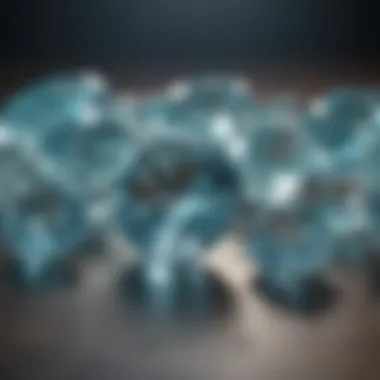
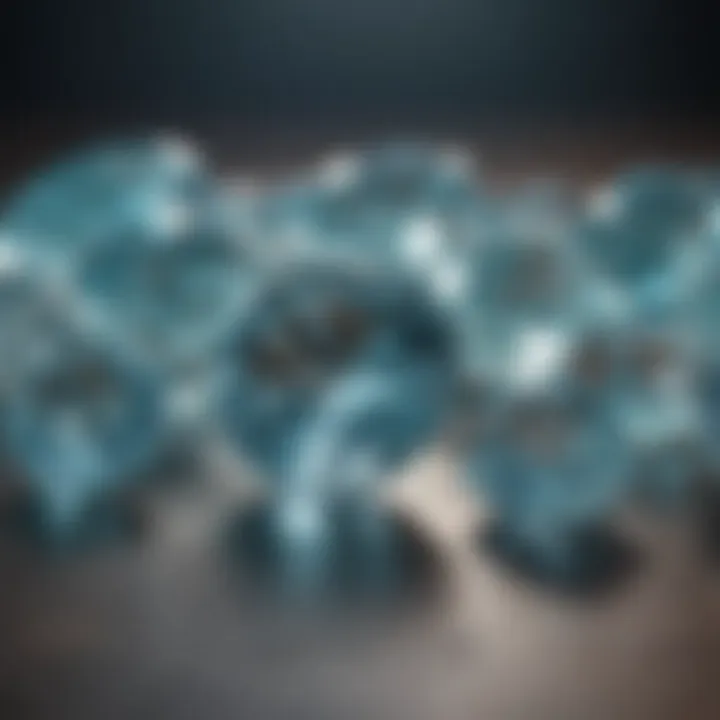
Intro
Aquamarine, with its captivating shades of blue and green, holds a special place not just in the realm of gemstones but also in cultural history. Many people may recognize aquamarine as the birthstone for March, but its significance goes far deeper than mere association with a month. This gemstone is steeped in lore, history, and a unique set of qualities that appeal to collectors, jewelry designers, and geology enthusiasts alike. As we journey through this article, we will explore the essence of aquamarine, uncovering its geological roots, historical significance, and symbolism, while also offering insight into its practical aspects such as care tips and current market trends.
Understanding aquamarine is akin to gazing through a clear ocean wave, where layers of meaning and beauty unfold before your eyes.
Gemstone Overview
Definition and Characteristics
Aquamarine is a variant of beryl, a mineral that also includes emerald and morganite. The name itself derives from the Latin "aqua marina," which translates to "water of the sea." This connection is evident in the stone's serene blue and green hues that echo the tranquil nature of marine environments. The color of aquamarine typically ranges from pale blue to deep blue, with the most coveted pieces displaying a rich, saturated color.
The gemstone has a hexagonal crystal structure, and its clarity often surpasses that of many other stones, making it highly desirable in jewelry making. A well-cut aquamarine captures light beautifully, resulting in a sparkle that mimics sunlight reflecting off ocean waves.
Classification of Gemstones
In gemology, stones are generally classified into two broad categories: precious and semi-precious. Aquamarine sits firmly in the semi-precious category, alongside other notable stones like amethyst and garnet. Unlike precious gemstones, which include diamonds, rubies, and sapphires, semi-precious stones may often be more accessible for the everyday consumer, making them ideal for those looking to adorn themselves with unique pieces without breaking the bank.
Aquamarine's popularity stems not just from its aesthetic appeal but also from its perception as a gemstone of calmness and clarity, traits that are especially valued in a fast-paced world. It is believed to evoke serenity and invigorate the spirit, casting a soothing spell on those who wear it.
"Aquamarine is not just a stone; it’s a talisman of peace, connecting us to the depths of the ocean and the calm of the skies."
Historical Significance
Ancient Uses and Cultural Importance
Historically, aquamarine has been cherished for thousands of years. Ancient Roman sailors brought the stone on their journeys, seeing it as a protective charm against the perils of the sea. The gem was often carved into talismans and worn to ensure safe passage through storms and treacherous waters.
In the middle ages, aquamarine was thought to hold magical powers. People believed it could help reconcile estranged lovers and was often used in wedding rings. The notion that this stone could bring harmony to relationships still resonates today.
Myths and Legends Surrounding Gemstones
Aquamarine is also steeped in myths that speak to its enchanting nature. One legend tells of a mermaid's treasure chest, discovered by sailors, filled with aquamarine stones. To possess aquamarine was to harbor the favor of marine spirits, encouraging peace and tranquility in the wearer's life.
In various cultures, aquamarine has been associated with courage, hope, and protection. Some even believed it could enhance the powers of the mind, sharpening intellect and fostering clarity in decision-making. The stories surrounding this gemstone offer a glimpse into humanity’s quest for meaning and understanding, reminding us of the deep connect we have with nature and the lore that enriches our lives.
As we delve further into the essence of aquamarine, we will explore its properties, market trends, and the joy it can bring both as an adornment and a piece of history.
Prologue to the March Birthstone
March brings about a sense of renewal and awakening in nature, marked by the arrival of spring. As the ice melts and flora begins to bloom, the aquamarine emerges as a symbol of this transition, embodying the tranquility and beauty of the ocean. This stunning gemstone, resembling the clear blue waters, holds not only aesthetic value but also deep cultural significance and rich lore.
Why Aquamarine is Significant
Aquamarine is more than just the birthstone for those born in March; it carries a captivating narrative woven into its very essence. Traditionally, aquamarine has been associated with various attributes, including calmness, clarity, and communication. Its soothing hues have inspired tales of sailors once believing that wearing aquamarine would protect them during their journeys at sea, reinforcing the stone's connection to water and safety.
In many cultures, aquamarine is said to confer a sense of peace, making it a popular choice in spiritual practices and emotional support. The implications of this gemstone extend into the realms of jewelry design, where it has found its way into contemporary pieces, marrying contemporary aesthetic with historical resonance.
Understanding the Importance of the Birthstone
Each birthstone serves as a personal talisman, often chosen due to its believed properties. For individuals born in March, aquamarine is thought to enhance creativity and dispel negativity, inviting positive energy into one’s life. People tend to find comfort and strength in its presence, using it as a reminder of personal resilience and emotional balance.
Key Elements to Explore
In this article, we will delve into not just the geological origins and physical properties, but also the metaphysical attributes and vast historical importance of aquamarine. Readers will gain insights into market trends regarding aquamarine, learn practical tips for purchasing and caring for the stone, and discover the resonant traditions associated with it through the ages.
"Aquamarine has a charm that transcends time, reminding us of the fluid beauty of nature and the power of calmness within chaos."
Understanding aquamarine as more than just a gemstone opens up avenues for appreciation among gemstone enthusiasts, collectors, and jewelry designers alike. As we explore deeper, we will recognize the layered complexities of this captivating stone, preparing enthusiasts to engage meaningfully with it in their own collections and practices.
The Geological Origins of Aquamarine
Understanding the geological origins of aquamarine not only enhances appreciation for this beautiful gemstone, but it also offers insights into its unique properties and characteristics. Aquamarine is a variety of beryl, a mineral that falls under the hexagonal crystal system. The presence of trace elements, particularly iron, is what infuses aquamarine with its distinctive blue to greenish-blue hue. This relationship between the mineral's formation and its eventual coloring makes it a fascinating subject for both gem enthusiasts and geology buffs.
Formation Processes
The formation of aquamarine is a geological journey that occurs over millions of years. Typically, aquamarine forms in granite pegmatites, which are coarse-grained igneous rocks. These pegmatites arise when molten rock cools slowly beneath the surface of the earth. As this happens, mineral-rich fluids concentrate in the remaining pockets left behind.
Several processes combine to create the perfect conditions for aquamarine to develop. First, high temperatures and pressures help facilitate the crystallization of minerals. Secondly, the presence of other minerals like feldspar and quartz can influence the final color and clarity of the aquamarine crystal. The interaction of these elements is akin to cooking a fine meal: you need just the right temperature, time, and ingredients to achieve a delicious result.
As aquamarine crystals are gradually formed, they can grow quite large, sometimes reaching several meters in length. However, it's the smaller gems that often find their way into jewelry, prized for their clarity and color.
Geographical Locations
Aquamarine isn't just a pretty face; it has a rooted history tied to specific geographical locations around the world. The most notable deposits of aquamarine are found in Brazil, especially in the states of Minas Gerais and Bahia. Brazilian aquamarines are renowned for their clarity and deep blue color, making them highly coveted in the gemstone market.
Other countries contributing to the aquamarine trade include:
- Pakistan: Notable for producing large, beautifully colored stones, often found in the region of Hunza Valley.
- Madagascar: Gems from this island nation exhibit a range of colors, often lighter and more pastel than their Brazilian counterparts.
- Nigeria: Known for high-quality aquamarine, offering stones that rival those from Brazil in terms of color intensity and clarity.
- Afghanistan: Specifically, the Nuristan region is known to produce stunning clear stones with vibrant hues.
Ultimately, the geographical origins of aquamarine contribute not just to its physical appearance, but also to its overall value in the gemstone market. Different regions yield different qualities, which makes aquamarine a global treasure cherished across cultures.
Physical Properties of Aquamarine
Understanding the physical properties of aquamarine is crucial for anyone who appreciates or works with this captivating gemstone. The beauty and value of aquamarine largely stem from its distinct physical characteristics, which includes its color, clarity, durability, and overall appeal. Knowledge of these attributes not only assists gemstone enthusiasts in selecting the best specimens but also helps jewelers in designing exquisite pieces that showcase aquamarine's virtues.
Color Variations and Clarity
One of the most enchanting features of aquamarine is its color. Often stepping into the realm of soft blues reminiscent of tranquil ocean waters, the intensity and hue can range from pale blue to vibrant blue-green. The clearer the stone, the higher its value tends to be. The variations arise from several factors, including the presence of iron within the mineral composition, which can influence the saturation and appearance of color.
Interestingly, light plays a pivotal role in how we perceive aquamarine. Under different lighting conditions, the hue can appear distinctively different. The clear, often transparent, nature of the best aquamarines allows for stunning light refraction, enhancing their brilliance and desirability.
"The finest aquamarines are often found with striking clarity and minimal inclusions, making them a favorite among collectors."
In addition to evaluating color and clarity, it’s worth noting that buyers should be keen on distinguishing between natural and treated stones. Enhanced stones may display more vibrant colors but can diminish in value if their treatment becomes visible.
Hardness and Durability
Aquamarine ranks a robust 7.5 to 8 on the Mohs scale of mineral hardness, which highlights its durability. This makes it suitable for various types of jewelry, from everyday wear like rings to more intricate designs used in necklaces or bracelets. Its hardness means you don’t have to baby it too much, but a little care goes a long way in maintaining its pristine condition.
When considering aquamarine for physical wearability, it’s essential to be mindful of its toughness, which refers to how well it resists breaks and chips. Aquamarine is generally reliable, but it can still fracture under severe impact, especially if the stone has internal flaws.
In essence, the physical properties of aquamarine not only lay the groundwork for its aesthetic appeal but also influence its usage in jewelry making. Understanding these features equips enthusiasts and professionals alike with the knowledge necessary to make informed decisions regarding its purchase, use, and care.
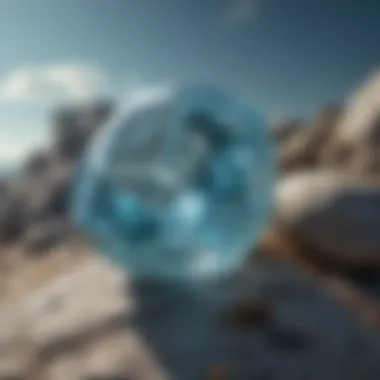
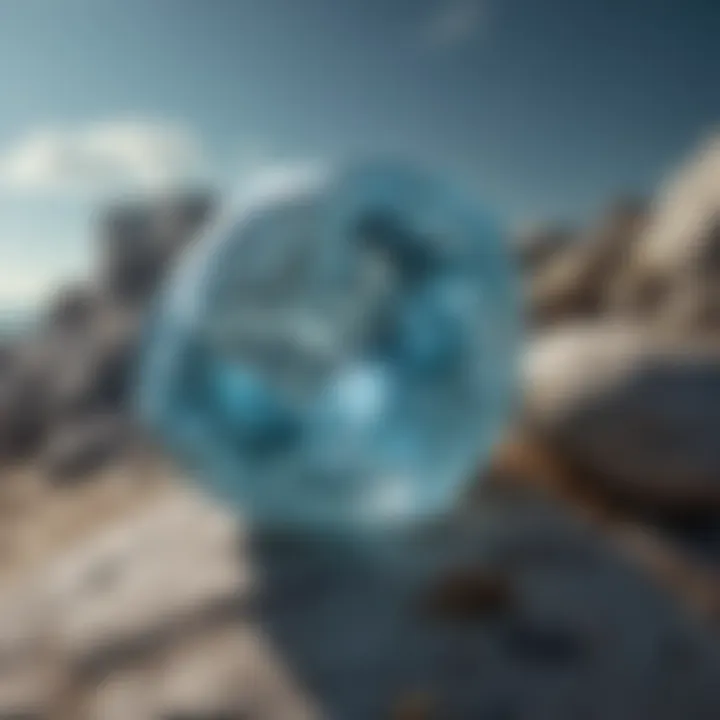
Metaphysical Properties of Aquamarine
Aquamarine has a long-standing reputation, not just for its physical beauty, but also for its metaphysical properties and benefits. Many believe that this stone holds the unique ability to promote emotional well-being and provide spiritual clarity. The significance of these metaphysical properties cannot be understated, especially for gemstone enthusiasts, collectors, and jewelry designers looking to deepen their understanding of aquamarine beyond mere aesthetics.
Emotional Healing
Diving into the emotional aspect, aquamarine is often termed as a stone of courage. It’s said to help one embrace the complexities of life’s challenges. Those who turn to aquamarine in times of stress or uncertainty might find themselves buoyed by the stone's purported ability to instill calmness. Many users report feeling less anxious, as if a weight has been lifted. It offers mental clarity and aids in reducing emotional turmoil, helping individuals to look at situations from a fresh perspective.
- Anchoring feelings: Aquamarine can help to center thoughts, making it easier to identify what truly matters.
- Better communication: This gem is also believed to promote clearer expression of emotions, enabling individuals to articulate their feelings more freely and honestly, which can be incredibly beneficial in resolving conflicts.
"Aquamarine encourages self-expression and clarity of thought. It acts as a bridge between the mind and heart, helping you convey not just words but also true feelings."
Spiritual Significance
On a spiritual level, aquamarine is associated with the throat chakra and carries energies related to intuition and connection. Those who engage with this gemstone may strive to deepen their spiritual practices or enhance their wisdom. Many spiritual practitioners regard aquamarine as a tool for promoting inner peace and facilitating meditation.
- Enhancing calmness during meditation: The serene blue shades of aquamarine may help one enter a meditative state more smoothly, fostering deeper connections during spiritual practices.
- Facilitating personal exploration: Individuals may find that aquamarine inspires deeper reflection on life’s journey, helping illuminate paths previously shrouded in doubt or confusion.
Additionally, this stone is often linked to sea deities in ancient lore, suggesting that its energies are tied to water's fluidity and adaptability. Just as water can change form and navigate obstacles, aquamarine encourages adaptability in one's life journey. Collectively, these elements make aquamarine a powerful ally not only for personal growth but also for fostering a broader sense of community and connection with others.
Historical Significance of Aquamarine
Aquamarine has captured the human imagination for centuries, weaving itself into the fabric of various cultures and traditions across the globe. Its historical significance is marked by its association with the sea, which not only shaped its name—derived from the Latin for "water of the sea"—but also its deeper meanings. This stone has often been revered for its purported qualities that impact emotional well-being and spiritual connection. It is important to delve into both cultural references and specific artifacts to truly appreciate how aquamarine has influenced history.
Cultural References
Aquamarine has often been mentioned in mythology and folklore, amplifying its appeal beyond mere beauty. Ancient sailors believed that carrying this stone would protect them while at sea, ensuring safe passage over tumultuous waters. In various cultures, it was seen as a talisman for good luck, and some even regarded it as a symbol of friendship and harmony. The Greeks and Romans associated aquamarine with the sea gods, attributing healing properties to it.
Moreover, aquamarine became a favored gemstone in royal jewelry. Queen Elizabeth II possessed a stunning aquamarine tiara, a testament to its status among the elite. Historically, wearing aquamarine was thought to enhance communication and bring serenity, making it a popular choice not only for personal adornment but also during significant life events like weddings and anniversaries.
"Aquamarine is not just a jewel; it’s a chapter in the story of human experience, connecting us to the mysteries of the waters and the spirituality they evoke."
Famous Aquamarine Artifacts
Throughout history, numerous aquamarine artifacts have stood out, demonstrating the stone's allure and significance. For instance, the famous aquamarine brooch gifted to Queen Mary of the United Kingdom in the early 20th century exemplifies royal elegance and heritage. This brooch, set in diamonds, was not just a decoration but a family heirloom that carried stories and sentiments through generations.
Another noteworthy mention is the aquamarine necklace worn by the late actress and activist Audrey Hepburn. Worn during her public appearances, it became a symbol of grace and beauty that echoed her humanitarian work.
In the context of ancient history, elaborate carvings and amulets made of aquamarine have been unearthed from archaeological sites, suggesting that past civilizations valued this gem as more than just decoration. These artifacts often depicted aquatic themes or figures, reinforcing the stone's connection to water and its purifying qualities.
Aquamarine's role in historical context serves both aesthetic and symbolic purposes, allowing it to transcend mere ornamentation and become a vessel of cultural identity, history, and emotional resonance. Its story continues to evolve, influenced by modern interpretations while respecting its rich lineage.
Aquamarine in Modern Jewelry
Aquamarine's serene beauty and striking hue make it a favored choice in modern jewelry designs. The gemstone's soft blue tones evoke tranquility, effortlessly complementing various styles. This section delves into two aspects: current design trends and the types of jewelry that prominently feature aquamarine. Understanding its place in contemporary creations not only highlights its aesthetic appeal but also informs enthusiasts and collectors about the evolving market.
Current Design Trends
In recent years, aquamarine has emerged as a versatile stone in the jewelry arena. One cannot ignore the rise of minimalist designs that prioritize simplicity. Here, a single aquamarine gemstone set in white gold or sterling silver becomes the centerpiece of a delicate ring or pendant. Such choices cater to individuals who appreciate subtleness over ostentation.
Furthermore, vintage styles have made a substantial comeback, incorporating aquamarine into art deco and retro-inspired pieces. Chunky settings and intricate embellishments showcase the stone's clarity and color, making it an ideal fit for bold statement jewelry.
Notably, the trend of personalized jewelry is also gaining traction. Customized pieces often feature aquamarine stones incorporated into birthstone rings or necklaces, providing individuality to the wearer.
Some of the hottest trends that have surfaced include:
- Layered Necklaces - Combining aquamarine pendants with various lengths and complementary stones creates an eye-catching arrangement.
- Mixed Metals - The fusion of gold, silver, and rose gold with aquamarine offers a modern twist, appealing to varied tastes.
- Nature-Inspired Designs - Leaf motifs and floral settings featuring aquamarine connect to natural themes, reinforcing a sense of organic beauty.
This evolving landscape supports aquamarine’s stature in modern jewelry by celebrating its unique traits while meeting contemporary aesthetics.
Types of Jewelry Incorporating Aquamarine
Aquamarine finds its way into a plethora of jewelry types, each highlighting the stone’s enchanting characteristics. Here’s a closer look at how this gemstone is embraced across various forms of adornment:
- Rings: Aquamarine rings stand out for engagements and everyday wear. Couples often choose aquamarine as a unique alternative to traditional diamonds, displaying individuality in their commitment.
- Earrings: From stud earrings featuring a single aquamarine gem to graceful dangles that catch the light, such pieces often complement both casual and formal attire.
- Necklaces: Aquamarine necklaces can range from simple pendants to lavish statement pieces adorned with diamonds or complementary stones. They are perfect for layering and adding a splash of color to any outfit.
- Bracelets: Aquamarine accents are commonly woven into beaded bracelets or bold cuff-style settings. These works often feature intricate designs that allow the stone's natural allure to shine.
- Brooches: Although less common now, brooches using aquamarine add a touch of elegance to jackets or hats, allowing wearers to display their affinity for unique stones.
"Aquamarine's popularity in jewelry reflects not only its visual appeal but also its ability to blend seamlessly into various styles."
To conclude, aquamarine's significance in modern jewelry is undeniable. Its aesthetic adaptability, coupled with current design trends, makes it not just a beautiful choice but also a thoughtful one for those in the market. Whether one is an enthusiast, a collector, or a designer, recognizing these elements enriches the overall appreciation of aquamarine and its place in contemporary adornments.
Market Trends for Aquamarine
Understanding the market trends for aquamarine is vital for anyone interested in gemstones, whether you’re a buyer, seller, or simply an aficionado. The dynamics at play can significantly affect purchasing decisions, valuations, and ultimately, the appreciation of this exquisite blue jewel. Recent years have seen shifts in supply chain dynamics and consumer preferences, which make it all the more necessary to keep a finger on the pulse of aquamarine's marketplace.
The following sections break down specific elements within this broader theme, leading us to gain insights into both price fluctuations and investment potentials.
Price Fluctuations
Price fluctuations of aquamarine are driven by various factors, making it essential to analyze recent trends. Firstly, the source of aquamarine plays a significant role. As mining operations in South America, particularly in Brazil and Nigeria, evolve, scarcity of high-quality stones may lead to an uptick in prices. Conversely, if new deposits are discovered, it can create a buyer's market, pushing prices down.
Several other influences also contribute:
- Quality Variance: Stones with a deep blue hue, less inclusions, and higher clarity typically command higher prices.
- Market Demand: Changes in consumer appreciation for this stone, often swayed by fashion trends and celebrity endorsements, can lead to abrupt price shifts.
- Seasonality: There may be specific periods when demand peaks, such as during spring jewelry shows or holidays, temporarily spiking prices.
To illustrate, in 2021, prices of high-grade aquamarine rose owing to a resurgence in interest for unique gemstones, alongside a decline in available stock from major sources. Fluctuations can be quite pronounced, so keeping abreast of these factors is crucial as they can mean the difference between a smart buy and a regrettable purchase.
Investment Potential
When it comes to investing in aquamarine, one doesn’t just grab any piece and hope for the best. A careful consideration of specific characteristics can influence both the reliability of the investment and the potential for return. In the world of gemstones, aquamarine has something of a reputation as a “safe” investment, especially in its high-quality forms.
Several points bolster its appeal as an investment:
- Historical Appreciation: Over time, well-maintained aquamarine pieces have shown a tendency to retain or increase in value, especially during economic downturns when tangible assets become more appealing.
- Rarity of High-Quality Stones: The better the color and clarity, the less likely they are to be found in abundance. Hence, investing in premium specimens could lead to significant returns in the long run.
- Market Recognition: Unlike some gemstones, aquamarine enjoys widespread recognition and desirability across various markets, making it a versatile investment choice.
Each aquamarine piece tells a story of its own, and every investment decision must be backed by adequate research into its origins, market conditions, and future trends. It's not merely about buying and holding; it involves engagement with a vivacious but volatile market.
"Buying aquamarine is not just about aesthetics; it’s about understanding the currents of the gem market."
Being informed about these market trends allows stakeholders not only to make savvy purchasing decisions but also to appreciate aquamarine as more than just a gem, but as a dynamic product intertwined with cultural and economic factors.
Tips for Purchasing Aquamarine
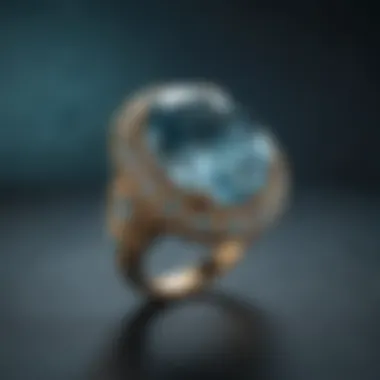
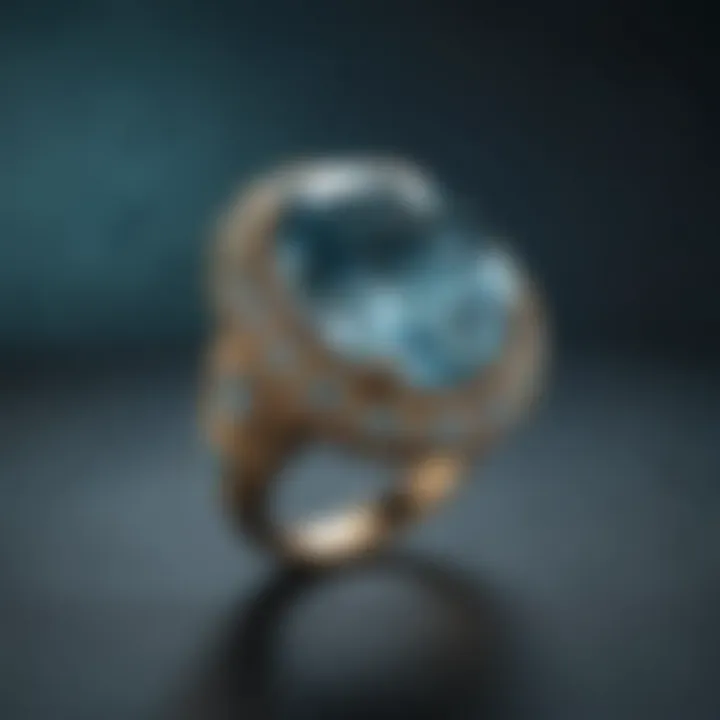
When it comes to buying aquamarine, knowing what to look for and how to approach the purchase can make all the difference. This gemstone, with its serene blue hues and captivating clarity, is not just an ornament. It's an investment in artistry, emotion, and history. Therefore, being well-prepared to make an informed decision is key. Whether you're a seasoned collector, a jewelry designer, or simply buying for a loved one, understanding the nuances of aquamarine can enhance both the purchasing experience and the overall value of your acquisition.
Evaluating Quality
Quality assessment of aquamarine largely hinges on several defining characteristics: color, clarity, cut, and carat weight. The shade of aquamarine is arguably its most distinguishing feature. A vivid, deep blue or blue-green color is most desirable. The more saturated the color, the more valuable the stone tends to be. But be cautious; too much green can detract from the overall appeal.
Clarity is another critical aspect. Look for stones that appear eye-clean, meaning there are no visible inclusions to the naked eye. Flawlessness is treasured, and the absence of blemishes will bump up the value significantly.
Next, consider the cut of the aquamarine. A well-executed cut enhances brilliance and reflects light beautifully. Styles like emerald cuts or oval cuts are popular, but each cut offers a different aesthetic, so it's worth exploring. Lastly, carat weight can influence pricing, but this should not overshadow the importance of the other aspects mentioned.
"Investing in aquamarine is not merely about the size; it’s about the beauty it brings with every glance."
In summary, when evaluating quality, zoom in on:
- Color: Look for a vibrant and even hue.
- Clarity: Aim for an eye-clean stone.
- Cut: Assess how light interacts with the gem.
- Carat weight: Remember it’s about quality over quantity.
Knowing Your Budget
Setting a budget before diving into the aquamarine market can help you remain focused and avoid overspending. Aquamarine prices fluctuate based on several factors, but understanding your financial boundaries allows you to filter out options that might put a dent in your wallet.
Generally speaking, you could find aquamarine at various price points. High-grade stones, especially those with intense color and flawless clarity, can command significant sums, sometimes reaching thousands of dollars per carat. However, more modest options can also be lovely and fitting for those with tighter budgets. It’s essential to balance your aesthetic desires with practical financial constraints.
Factors influencing the cost include:
- Quality of the stone: As mentioned, color and clarity matter.
- Origin: Some mines produce more desirable gems than others; for example, stones from Brazil are renowned.
- Market demand: The current market trends also impact prices.
In addition, some sellers may offer pay-over-time plans, which can ease the financial strain. Setting a budget with some wiggle room can serve you well, allowing you to make a choice based on quality while staying within your means. The key is to feel satisfied with your purchase, both emotionally and financially.
With these tips in mind, you can navigate the aquamarine market confidently, ensuring your choice aligns with your style preferences, quality expectations, and budget realities.
Caring for Aquamarine
Taking care of aquamarine is a crucial aspect that any gemstone enthusiast should consider. Aquamarine, with its vibrant hues reminiscent of the ocean, deserves diligent maintenance to preserve its beauty and longevity. Proper care not only protects the gemstone but also ensures that it remains a cherished piece, whether set in jewelry or held as a collector’s item.
Cleaning and Maintenance
Cleaning aquamarine should be approached with careful consideration, as improper methods can lead to damage. Unlike some stones that can withstand harsh conditions, aquamarine is more delicate. Regular cleaning helps to remove dust and grime that can accumulate over time. Here are some effective strategies for maintaining your aquamarine's shine:
- Warm Soapy Water: A simple solution of mild dish soap and warm water works wonders. Use a soft cloth to gently rub the stone and rinse it under lukewarm water.
- Avoid Harsh Chemicals: Stay away from bleach or acetone, which can tarnish or cloud the stone.
- Soft Toothbrush: For pieces with intricate designs, a soft-bristled toothbrush can help reach crevices, ensuring a thorough clean.
- Dry Gently: After washing, use a lint-free cloth to wipe the aquamarine and avoid scratching its surface.
Remember that routine maintenance is advisable. Just as you would clean valuable items in your home regularly, this gemstone requires the same respect.
Storage Recommendations
Proper storage is key to keeping aquamarine in pristine condition. Many collectors overlook this aspect, which can lead to unintentional nicks and scratches. Here are a few guidelines on how to properly store aquamarine:
- Individual Pouches: Store each piece in a soft pouch or cloth bag to prevent scratches caused by contact with other items. This is especially crucial for jewelry, where stones may rub against each other.
- Jewelry Box with Dividers: If using a jewelry box, choose one with dividers to keep pieces separated. This reduces the chances of stones clanging against one another, causing potential damage.
- Away from Sunlight: It’s best to keep aquamarine away from direct sunlight for prolonged periods, as UV rays can lead to color fading and diminish its shine over time.
- Controlled Environment: Ideally, store your aquamarine in a cool, dry place. Humidity and extreme temperatures can affect its clarity and durability.
Keeping your aquamarine in excellent condition ensures that it continues to evoke the timeless beauty of the sea, enhancing its allure and emotional value.
In summary, caring for aquamarine involves thoughtful cleaning and strategic storage methods. By taking these measures, enthusiasts, collectors, and designers can ensure that their aquamarine pieces remain stunning and vibrant for years to come.
Aquamarine in Birthstone Lore
Aquamarine, the tranquil blue gem often associated with the ocean, holds a prominent place in the lore of birthstones, particularly for the month of March. Its clear, soothing color and unique characteristics have woven it deeply into various cultures and beliefs throughout history. Exploring aquamarine's role in birthstone lore not only highlights its beauty but also illustrates its deeper significance in human experience.
Symbolism and Meaning
Aquamarine is steeped in a variety of symbolic meanings, which have evolved and adapted from ancient times to the present. Often, it is seen as a stone of clarity, representing purity and serenity. The blue hues echo the ocean, symbolizing peace and tranquility which makes it a favorite for those seeking calmness in their lives.
Additionally, many believe that aquamarine can enhance communication. This notion stems from its association with the throat chakra in metaphysical traditions, believed to help express one's thoughts and feelings clearly. In this way, aquamarine acts as a bridge, allowing for better understanding and harmony in relationships.
Among certain groups, it is considered a protective stone, especially for sailors and travelers, promising safe passage across waters and shielding against harm.
Rituals and Traditions
Various rituals and traditions have sprung up around aquamarine, reflecting its importance in cultural practices across different societies. Many cultures recognize the stone’s ability to foster emotional healing and, as such, have incorporated it into healing rituals. For instance:
- Cleansing Ceremonies: People often use aquamarine crystals in cleansing rituals to rid themselves of negative energy. This may involve bathing the stones in moonlight or saltwater as a part of their cleansing process.
- Wedding Gifts: In some traditions, aquamarine is given as a wedding gift, symbolizing love, harmony, and fidelity in marriage.
- Birthstone Celebrations: Every March, those born in this month celebrate their connection to aquamarine through family gatherings and special rites, often wearing or gifting the stone to mark their birthdays.
"An aquamarine is not just a gem; it is a reminder of the serene waters of life and the promises they hold."
It's clear that aquamarine's significance extends well beyond its physical attributes. Its rich tapestry of meanings and the rituals that surround it speak to the human desire for connection, understanding, and peace in life. By incorporating aquamarine into personal practices, many find a deeper sense of awareness and tranquility.
Alternative March Birthstones
When discussing the birthstones for March, aquamarine often takes center stage due to its striking hues and calming associations. However, the world of gemstones is large and varied; thus, March's neighboring stones deserve acknowledgment as well. Understanding these alternative stones not only broadens one’s appreciation of this time-honored tradition, but it also provides options for those who might seek something unique or different. Such elements can include aesthetic preferences, personal symbolism, or simply the search for rarity.
Other Notable Stones
Among the notable alternatives for March, bloodstone stands out. This dark green stone, flecked with red spots, is a chalcedony esteemed since ancient times for its alleged healing properties and connections to vitality. It has been worn by many throughout history; in fact, medieval warriors often carried bloodstones as talismans to gain courage in battle.
Jasper is another contender in the alternative field. Known for its variety of rich and warm patterns, jasper speaks to those who enjoy earthy aesthetics. With its myriad forms, from the deep reds of red jasper to the soft pastels of picture jasper, it appeals to many folks seeking a vibrant yet grounded stone.
- Bloodstone: Known for its strength and vitality.
- Jasper: Offers beautiful patterns and earthy tones.
Comparative Analysis
When weighing aquamarine against its alternatives like bloodstone and jasper, several factors should come into play. For starters, color and clarity distinguish aquamarine with its crisp blue shades compared to the deep greens and reds of bloodstone and the mottled blend of colors found in jasper. This can affect aesthetic choices significantly, as some individuals prefer a more serene hue like aquamarine, while others may be drawn to the dramatic textures and colors of jasper.
Additionally, the emotional and metaphysical properties between these stones differ markedly. Aquamarine is thought to promote serenity and calmness, often used for emotional healing, whereas bloodstone is aligned with courage and empowerment. Jasper, on the other hand, is often linked to nurturing energies and stability, making it a great choice for grounding.
Moreover, in terms of market trends, aquamarine tends to maintain higher values due to its popularity and demand, whereas bloodstone and jasper may be more accessible for budget-conscious individuals.
that speak to various tastes, beliefs, and traditions. This insight not only enriches one's journey through their own or a loved one's birthstone selection but also highlights the importance of personal resonance when choosing a gemstone.
Influence of Aquamarine in Art
Aquamarine's ethereal beauty and captivating hues have left an indelible mark on the world of art. This section delves into how this striking gemstone influences artistic expression, ranging from traditional masterpieces to modern interpretations that reflect the cultural zeitgeist.
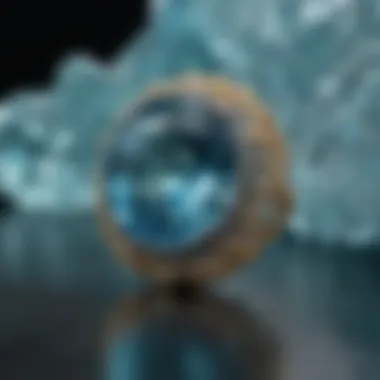
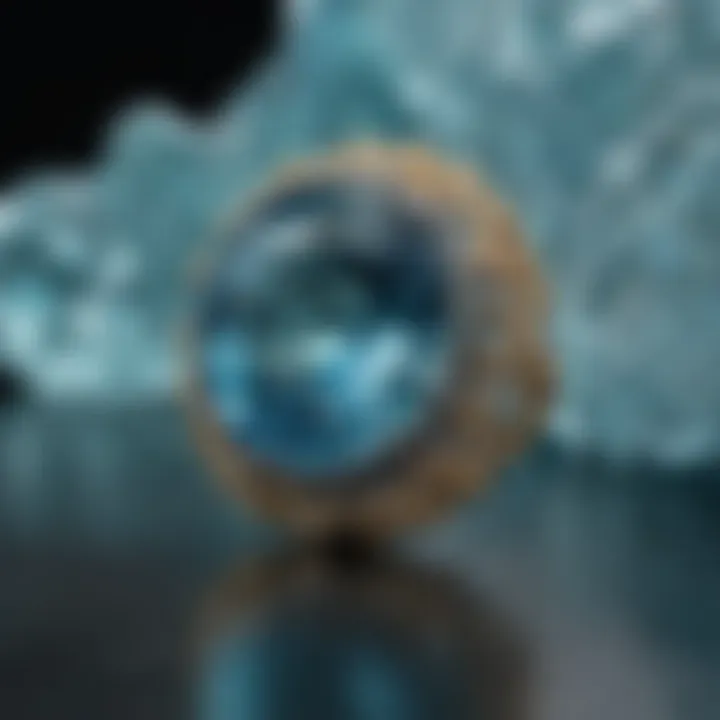
Historical Artwork
Historically, aquamarine has inspired many artists, jewelers, and craftsmen. In ancient Rome, it was believed to promote harmony and tranquility. Artists featured the gemstone in sculptures, jewelry, and religious artifacts, embodying its serene blue shades. Aquamarine was often associated with the sea and its many myths.
For instance, during the Renaissance, painters commonly incorporated aquamarine in their palettes, utilizing its vibrant tones to evoke feelings of calm and depth in their works. One prominent example is the painting "The Birth of Venus" by Sandro Botticelli, where sea colors portray harmony and beauty. The reflections and hues of the ocean became symbolic of purity, much like the properties attributed to aquamarine itself.
Contemporary Interpretations
In recent years, artists continue to embrace aquamarine in various forms, using it as both a thematic and material element. Sculptors create breathtaking installations integrating aquamarine or its colors, capturing the ever-changing nature of water and light. Contemporary jewelers imbue traditional designs with aquamarine, modernizing ancient techniques into striking pieces that resonate with today’s sensibilities.
Moreover, visual artists have also drawn inspiration from aquamarine's symbolism in their works, often focusing on themes surrounding tranquility and peace. Paintings that explore water motifs frequently feature aquamarine hues to enhance their emotional impact.
"Art is the most beautiful of all lies." – Claude Debussy
The duality of aquamarine, representing both the calming effects of the sea and the dynamic movements of water, becomes a powerful tool in storytelling. This interplay captures the viewer's imagination, allowing for deeper connections to emotions and experiences.
Aquamarine Legends and Myths
Exploring the legends and myths surrounding aquamarine offers a captivating glimpse into how this stunning gemstone has influenced cultures throughout history. Each story weaves a rich tapestry of beliefs and interpretations, often elevating aquamarine beyond a mere ornament to something of greater significance and power. This section dives into the legendary essence of aquamarine, focusing on its ancient roots and modern interpretations, thereby enhancing our understanding of its allure.
Ancient Beliefs
In the cradle of ancient civilizations, aquamarine was believed to be a precious gift from the sea, revered by sailors as a stone of good fortune. The Greeks, for instance, associated aquamarine with Poseidon, the god of the ocean. They often carried this blue treasure on their journeys, believing it would calm storms and ensure a safe passage over turbulent waters.
In Roman lore, aquamarine was thought to provide clarity and harmony, protecting those who wore it from danger. It was often used in amulets and talismans, imbuing users with bravery and resilience. The stone was also associated with love, considered a blessing for couples embarking on marriage.
Key elements of ancient beliefs include:
- Safety in travel: Sailors cherished aquamarine as a protective talisman against maritime disasters.
- Promoting love: Used in wedding ceremonies, the stone symbolized unconditional love and fidelity.
- Spiritual protection: Ancient cultures believed that wearing aquamarine would shield them from harm during battles and conflicts.
Modern Interpretations
Fast forward to today, aquamarine still garners a significant reputation in various contexts. Many people now view this gemstone as a symbol of tranquility and clarity. The calming shades of blue are believed to inspire a connection to the sea and its peaceful depths. Hence, aquamarine is often associated with serene environments, mindfulness, and a balanced emotional state.
Modern healers and metaphysical practitioners point to aquamarine's ability to facilitate open communication and alleviate stress. This gemstone continues to be a favorite for those seeking to enhance their mental clarity or harness emotional stability. Moreover, its aesthetic beauty and symbolism make it a common choice for contemporary jewelry designs.
Significant aspects of modern interpretations include:
- Emotional clarity: Promoted as a stone that fosters clear communication and emotional healing.
- Aesthetic appeal: Its outstanding beauty remains a popular choice in both casual and high-end jewelry.
- Mindfulness and healing: Practitioners use aquamarine in alternative healing to promote balance and reduce anxiety.
In both ancient and modern contexts, the legends surrounding aquamarine reveal our everlasting admiration for this unique gemstone's beauty and profound meanings.
Environmental and Ethical Aspects
The conversation around gemstones isn't just about beauty and rarity anymore; environmental conditions and ethical sourcing have come to the forefront. When it comes to aquamarine, the significance of these elements is profound. Many consumers today are not merely interested in the end product but are equally concerned about the story behind it—how and where it was mined, and whether its journey contributes to or detracts from the planet's health.
The importance of ethical aspects in aquamarine mining is tied closely to decisions made by consumers, jewelers, and corporations alike. Sustainable practices can protect endangered ecosystems and ensure that local communities aren't just surviving but thriving. Furthermore, as a beautiful blue gem, aquamarine serves as a reminder of the oceans and the need to protect our water bodies. Many regions from where aquamarine is extracted face issues of pollution and habitat destruction due to mining activities. By emphasizing sustainable and ethical practices, the aquamarine market can play a vital role in fostering environmental stewardship and social responsibility.
Sustainable Sourcing
Sustainable sourcing of aquamarine involves methods of extraction that minimize environmental impact. This means using techniques that do not overly deplete resources or harm surrounding ecosystems. For instance, opting for artisanal mining operations that prioritize local community involvement rather than larger corporate setups can often lead to a more responsible approach. Local miners often have a vested interest in keeping their environment intact, as it's their home and livelihood.
Additionally, companies that source aquamarine sustainably often take extensive measures to conserve water and energy while reducing waste. Some practical steps include:
- Investing in renewable energy sources for mining operations.
- Employing methods that lead to less soil erosion and less water usage.
- Supporting local flora and fauna through habitat preservation initiatives.
Choosing aquamarine that has been sustainably sourced not only enhances its value but also supports practices that keep our planet healthy. It connects consumers with the story behind the gem, a narrative often overlooked in the hustle of jewel-making.
Certification Standards
In an age where transparency is key, certification standards play a crucial role in the aquamarine market. Certificates often indicate that a stone has been ethically sourced. These standards serve as a guarantee, ensuring that the gemstone is not only genuine but also sustainably mined. Organizations exist that evaluate and provide certifications based on specific environmentally-friendly criteria, ensuring consumers feel confident about their purchases.
For example, the Responsible Jewellery Council and Fair Trade Gemstones initiative set out clear criteria for what constitutes ethical sourcing. These include:
- Validation of mining practices to ensure low environmental impact.
- Compliance with labor rights for workers in the mining sector.
- Assurance that communities benefit from the mining activities through support for local projects.
Having aquamarine that comes with such certifications assures buyers that they’re not just acquiring a beautiful piece of jewelry but are also participating in global efforts for a fairer economy and a healthier environment. Manufacturers that adhere to these standards are paving the way for a more responsible approach in the luxury market.
Future Prospects for Aquamarine
As we delve into the future of aquamarine, it becomes evident that this stone holds much promise. Its unique beauty and historical significance have always appealed to many, but as we step into a new age, the relevance and application of aquamarine extend beyond mere aesthetics. Understanding what lies ahead can help enthusiasts, collectors, and jewelry designers make informed decisions about acquiring this coveted gemstone. There are also several fascinating technological developments that are poised to redefine how this precious stone is sourced and valued.
Technological Advances in Extraction
New technologies are taking the stage when it comes to mining and extracting aquamarine. In recent years, advancements in sustainable mining techniques have emerged, aiming to minimize the environmental impact traditionally associated with gemstone extraction. For instance, new laser-based cutting technology reduces wastage when processing rough stones, ensuring more of the gem enters the marketplace. This is significant because it can lead to lower prices and increase availability without the ethical concerns that often come with gemstone mining.
Moreover, 3D mapping and drone technology are revolutionizing how mining operations are planned. These innovations allow companies to identify rich deposits from the air before setting foot on the ground, leading to smarter and more efficient extraction methods. Less ground disturbance and better resource management are big wins for both the industry and the environment.
Forecasting Market Trends
As consumers become increasingly aware of ethical sourcing, market trends for aquamarine are shifting. More buyers are examining not only the quality and beauty of the stones but also the conditions under which they are mined. Hence, companies that prioritize sustainable practices may gain a competitive edge.
Experts predict a rise in demand for aquamarine due to its stunning appearance and metaphysical properties, particularly among millennials and Gen Z consumers who are drawn to unique, responsibly sourced items.
Another important factor to consider is the influence of social media on market trends. Platforms like Instagram and Pinterest have turned the spotlight on aquamarine, influencing buying behaviors through visual appeal and trendy promotions. Posts showcasing aquamarine jewelry can stir interest and create a surge in demand, impacting prices and availability.
"The future price of aquamarine will likely reflect not just quality but the values that resonate with today's conscious consumers."
Finally, auctions and specialized gemstone shows are becoming more prevalent, providing platforms to showcase and sell aquamarine. As these events gain traction, collectors and investors can expect to see prices driven upward as unique and high-quality stones garner more attention.
Ending
As we wrap up our extensive exploration of aquamarine, it's vital to reflect on the manifold signficance this gemstone holds, particularly for those born in March. The insights gleaned from understanding its geological origins to the cultural nuances reveal just how layered the narrative of aquamarine can be.
Aquamarine is not just another pretty stone—it's a vessel of history, emotion, and market fluctuations. Its color variations, ranging from pale blue to deep teal, evoke feelings of tranquility while symbolizing clarity and clarity in communication. This makes aquamarine more than just a birthstone; it's often associated with emotional healing and spiritual growth.
When we consider the historical significance, countless cultures have cherished aquamarine, associating it variously with hope, protection during long journeys, and even as a treasure of mermaids. Such stories add depth to the physical beauty, creating a rich tapestry of lore that enchants both collectors and laypersons alike.
In the realm of modern jewelry, aquamarine continues to shine, finding its way into current design trends. The unique touch of this gemstone elevates contemporary pieces, making them not just accessories but emblems of personal stories. For those in the business of crafting or purchasing fine jewelry, understanding these trends can significantly enhance their choices and potential investments.
The article also highlights the importance of ethical considerations in gemstone sourcing. As consumers become more socially conscious, the demand for sustainability in sourcing is paramount. By choosing aquamarine that adheres to high standards of ethical practice, buyers contribute to a more equitable market.
In summary, the facets of aquamarine extend far beyond its stunning appearance. It's a gemstone steeped in rich lore, emotional resonance, and practical considerations regarding care and authenticity. Whether it's for an individual’s personal collection or a thoughtful gift, understanding aquamarine's significance can enrich the experience profoundly.
"The beauty of aquamarine lies not only in its hue but also in its deep historical and emotional connections, making it a perfect companion for those navigating life’s waters."
As we continue to delve into the world of gemstones, aquamarine stands out as a compelling example of how a seemingly simple stone can encapsulate centuries of culture, beauty, and value.







